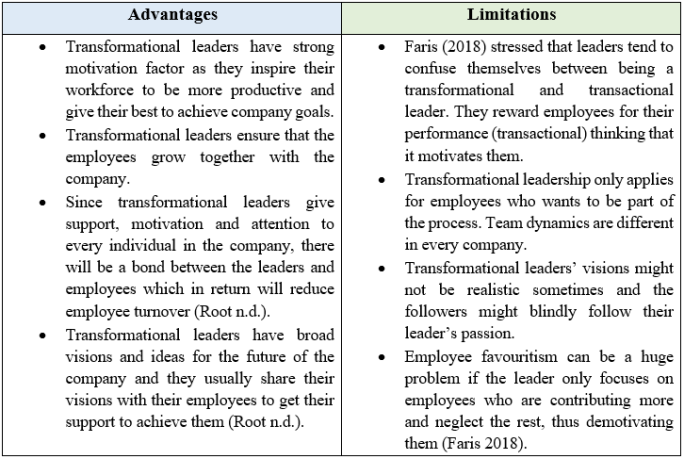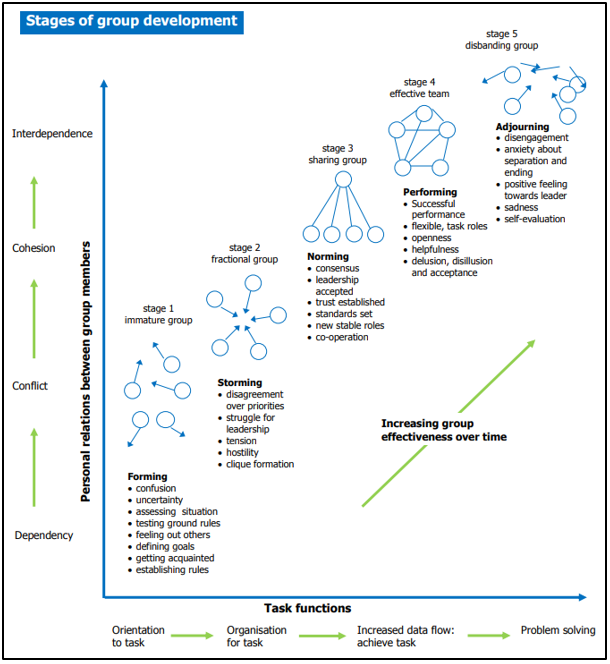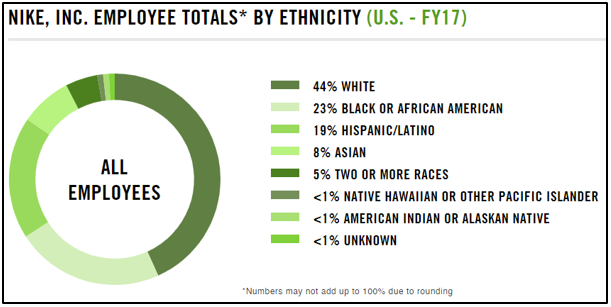Introduction
Throughout the past ten weeks, I’ve been exposed to various important leadership components in the INTM05LON Leading in a Changing World module in my MBA programme by my lecturer Dr Poh Phaik See. Firstly, I would like to thank her for sharing so much of knowledge and for encouraging other MBA students who are working to share their experiences on leadership. I’ve gained so much by just listening in this class. After reading and writing blogs on various leadership components such as ethics, diversity, change management and leadership styles, my vision on leadership is to not become a good leader but a great one. According to Jeff Mask (2015), good leaders will have followers, but great leaders make more leaders. Good leaders are people with a wide range of skills, good communications, strategists and constantly encourage their followers to excel (Brandon 2015). Great leaders are surrounded by great people (Brandon 2015).
 Figure 1: Tom Peters’ quote on leadership (Source: Spagnuolo 2013)
Figure 1: Tom Peters’ quote on leadership (Source: Spagnuolo 2013)
My Vision of Leadership
I believe that the transformational leadership style is the most suitable and closely related to my vision of leadership. The personality test that I have taken also suggests just that. Based on 16Personalities.com (2018), I have the “ESFJ-A” also known as “The Consul” personality where they mentioned that I am a people person, supportive and a leader who leads their team to victory. According to the personality test, I am a leader who wants to feel appreciated, happy to help others and a leader who would include everyone in an organization to achieve something and create the sense of togetherness. This test surprised me as I do agree with their analysis of my personality and the truth in it. Relating to that, I believe I can be a good transformational leader.
 Figure 2: My personality test (Source: 16Personalities 2018)
Figure 2: My personality test (Source: 16Personalities 2018)
However, I would like to revisit and address my Blog 3 on “Most Effective Leadership & Management Styles & Approaches”. In that blog, I have mentioned that there is no single ideal leadership style and the best approach depends on the situation and behaviour of individuals in the organization (CMI 2013). In my opinion, a blend of transformational and situational leadership style is important to be a great leader.
Hersey & Blanchard’s Situational Leadership Model
Hersey & Blanchard’s situational leadership model proposed that the leaders need to choose the best style according to the situational variables (Cherry 2017). This model suggests that there is no one single best leadership style. According to this model, effective leaders are those capable of adapting their leadership style based on the situation, nature of the task, group and other key factors that contributes in getting a task done (Cherry 2018). Hersey & Blanchard’s situational leadership model below matches the leadership styles according to the suitable maturity levels:
 Figure 3: Hersey & Blanchard’s Situational Leadership Model (Source: Tools4management n.d.)
Figure 3: Hersey & Blanchard’s Situational Leadership Model (Source: Tools4management n.d.)
Hersey & Blanchard stressed that there are four key leadership styles:
 Table 1: Leadership styles (Source: Cherry 2018)
Table 1: Leadership styles (Source: Cherry 2018)
 Table 2: Maturity levels (Source: Cherry 2018)
Table 2: Maturity levels (Source: Cherry 2018)
My Role Model?
 Figure 4: Richard Branson, founder of Virgin Group (Source: Middleton 2016)
Figure 4: Richard Branson, founder of Virgin Group (Source: Middleton 2016)
Richard Branson is a British entrepreneur and investor who founded Virgin Group which controls more than 400 companies around the globe (Wachman 2012). He founded and invested in a many array of businesses from media, music, entertainment to airline and telecommunications (Wachman 2012). Branson inspired me a lot because he has good situational leadership skills. He constantly looks for opportunities to form new feasible ventures and perfected the art of controlling situations in his organizations (Chris 2015). He has proven his ability to implement changes at an incredible rate in multiple occasions. On top of that, Branson is also a transformational leader who can adapt quickly to changes in cultures within his organizations (Chris 2015). He has bought multiple firms and successfully moved to new locations with his staff over the years. Richard Branson always puts his staffs’ interest first as he believes it inspires and motivates them to perform better and feel appreciated.
A short video of Sir Richard Branson explaining his leadership style:
Source: Unfiltered (2017) Leadership Style Of Sir Richard Branson [online] available from <https://www.youtube.com/watch?v=8bAf9WEdkxw> [16 July 2018]
Feedbacks from My Colleagues
Below are the feedbacks I have received from my colleagues where they have rated me based on my leadership skills and individual characteristics that they have noticed in me for the past ten weeks.

 Table 3: My colleagues’ feedback on my leadership
Table 3: My colleagues’ feedback on my leadership
I am surprised and thankful to my colleagues for their feedback and good support. Based on their feedback, I believe I do have good leadership skills. I also understand that I need to work harder to perfect my leadership skills. I aspire to work in a large tech company such as Google or Samsung one day. I want to lead and inspire people in my organization to create and innovate products that can change people’s life.
Conclusion
My goal is to learn as much as I can on leadership, management and critical decision-making skills throughout the remaining two semesters in my MBA programme. I’ve learned a ton from my first semester and I hope to do the same the next semester. I will continue to volunteer myself to be the group leader for group assignments in upcoming modules to improve my leadership and decision-making skills. I plan to reflect on my blogs to remind myself the importance of ethical leadership, managing diverse teams, effective leadership styles and change management to improve my leadership skills. On top of that, I also plan to write more blogs related to tech and business in the future as I find it to be an interesting way to learn and share the knowledge I learned with others.
References:
16Personalities (2018) ESFJ Personality (“The Consul”) [online] available from <https://www.16personalities.com/esfj-personality> [16 July 2018]
Brandon, J. (2015) One Big Difference Between Good Leaders And Great Leaders[online] available from <https://www.inc.com/john-brandon/one-big-difference-between-good-leaders-and-great-leaders.html> [16 July 2018]
Cherry, K. (2017) The Major Leadership Theories [online] available from <https://www.verywellmind.com/leadership-theories-2795323> [26 June 2018]
Cherry, K. (2018) Situational Theory Of Leadership [online] available from <https://www.verywellmind.com/what-is-the-situational-theory-of-leadership-2795321> [26 June 2018]
Chris, J. (2015) Richard Branson Leadership Style Commandments [online] available from <http://www.josephchris.com/richard-branson-leadership-style-commandments> [16 July 2018]
CMI (2013) Understanding Management Styles Checklist 236, Chartered Management Institute: London
Mask, J. (2015) Why Good Leaders Have Followers And Great Leaders Make More Leaders [online] available from <https://www.huffingtonpost.com/jeff-mask/good-leaders-vs-great-lea_b_6509314.html> [16 July 2018]
Mullins, L. (2010) Management And Organisational Behaviour. 9th edn. Harlow: Pearson
Wachman, R. (2012) Virgin Brands: What Does Richard Branson Really Own? [online] available from <https://www.theguardian.com/business/2012/jan/08/virgin-brands-richard-branson-owns> [16 July 2018]
Image Sources:
16Personalities (2018) ESFJ Personality (“The Consul”) [online] available from <https://www.16personalities.com/esfj-personality> [16 July 2018]
Middleton, Y. (2016) Richard Branson Founder Of Virgin Group [online] available from <https://addicted2success.com/quotes/76-intelligent-richard-branson-quotes/> [16 July 2018]
Spagnuolo, V. (2013) Tom Peters Quote On Leadership [online] available from <http://www.hashslush.com/live-from-wbfmi-world-of-business-idea-milan/> [16 July 2018]
Tools4management (n.d.) The Hersey-Blanchard Situational Leadership Theory – A Study [online] available from <https://www.tools4management.com/article/the-hersey-blanchard-situational-leadership-theory-a-study/> [26 June 2018]

 Table 1: Values from resistance
Table 1: Values from resistance Figure 1: Kurt Lewin (Source: Goodreads n.d.)
Figure 1: Kurt Lewin (Source: Goodreads n.d.) Figure 2: Lewin’s Change Management Model (Source: ScienceSoft 2017)
Figure 2: Lewin’s Change Management Model (Source: ScienceSoft 2017) Table 2: Lewin’s model explained
Table 2: Lewin’s model explained Table 3: Advantages and limitations of Lewin’s model (Mulholland 2017)
Table 3: Advantages and limitations of Lewin’s model (Mulholland 2017) Figure 3: Microsoft logo (The Verge 2012)
Figure 3: Microsoft logo (The Verge 2012) Figure 4: Satya Nadella, CEO of Microsoft (Source: Weinberger 2016)
Figure 4: Satya Nadella, CEO of Microsoft (Source: Weinberger 2016) Table 1: Leadership vs Management – Similarities (Source: Juneja n.d.)
Table 1: Leadership vs Management – Similarities (Source: Juneja n.d.) Table 2: Leadership vs Management – Differences (Source: Arruda 2016)
Table 2: Leadership vs Management – Differences (Source: Arruda 2016) Figure 1: Transformational leadership model (Source: EBA n.d.)
Figure 1: Transformational leadership model (Source: EBA n.d.) Table 3: Components of transformational leadership (Source: Cherry 2018)
Table 3: Components of transformational leadership (Source: Cherry 2018) Table 4: Advantages and limitations of transformational leadership style
Table 4: Advantages and limitations of transformational leadership style Figure 2: Steve Jobs (Source: Wikipedia 2018)
Figure 2: Steve Jobs (Source: Wikipedia 2018) Figure 3: Bill Gates (Source: Schoeller 2017)
Figure 3: Bill Gates (Source: Schoeller 2017) Table 1: Advantages of having diverse workforce
Table 1: Advantages of having diverse workforce Table 2: Disadvantages of having diverse workforce
Table 2: Disadvantages of having diverse workforce Figure 1: The Tuckman model flow (Source: Hillary n.d.)
Figure 1: The Tuckman model flow (Source: Hillary n.d.) Figure 2: Stages of group development (Source: Nestor 2013)
Figure 2: Stages of group development (Source: Nestor 2013) Figure 3: Nike ethnic diversity ratio in U.S (Source: Nike 2018)
Figure 3: Nike ethnic diversity ratio in U.S (Source: Nike 2018) Figure 4: Nike global gender diversity ratio
Figure 4: Nike global gender diversity ratio Figure 5: Pay equity changes in U.S and globally (Source: Nike 2018)
Figure 5: Pay equity changes in U.S and globally (Source: Nike 2018) Figure 6: Mike Parker CEO of Nike, Inc. (Source: Samad 2018)
Figure 6: Mike Parker CEO of Nike, Inc. (Source: Samad 2018) Table 1: Explains the benefits and limitations of Deontological and Teleological theories
Table 1: Explains the benefits and limitations of Deontological and Teleological theories Figure 1: The 4-V Model of Ethical Leadership (Source: The Centre for Ethical Leadership 2016)
Figure 1: The 4-V Model of Ethical Leadership (Source: The Centre for Ethical Leadership 2016) Figure 2: Elon Musk (Source: Lam 2017)
Figure 2: Elon Musk (Source: Lam 2017) Figure 3: Mark Zuckerberg (Source: Senn 2017)
Figure 3: Mark Zuckerberg (Source: Senn 2017)